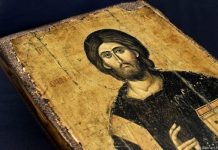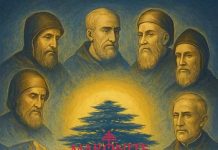Explanation Of The Maronite Divine Liteurgy and Its Traditions
The Ritual of the Holy Mass according to the Antiochene Maronite Catholic Church that is today celebrated, has its origins in the ancient rites of the Universal Apostolic Church established centuries ago by Jesus Christ and by his Apostles. Since establishment of the Church by Christ, many diverse forms of Christian worship have developed. In the same period, the rites and customs observed by the Maronites have progressed and flowered into the form which can be seen on God’s Altar today.
Consequently, through periodic reforms in the liturgy since the days of early Christianity, the Church has attempted to give its faithful a deeper comprehension of and appreciation for the spiritual meaning of the Mass, and in addition, has tried to give a better understanding of the spiritual benefits to be derived by those who partake in the Holy Sacrifice.
The most recent reform in the Maronite liturgy came about as a resent of Vatican II. On December 4, 1963, the Vatican Ecumenical Council issued a decree entitled ” The Liturgy.” In accordance with the terms of the decree and the wishes of the Maronite Clergy, 1) The Vatican Ecumenical Council. 2) The Maronite Bishops. 3) Other Members of the Maronite belief, clergy and laity alike. 4) The Maronite Patriarch in Lebanon who was empowered (by the terms of the regulations issued November 21, 1965, pertaining specifically to the Eastern Church and being part of the Ecumenical Decrees of Vatican II) to reform the liturgy of the Maronite Church, Hs Eminence Cardinal Patriarch Peter Paul Meouchi in a patriarchal decree, dated April 13, 1973, ordered the priests of the Maronite Church to amend the Mass and to use the new Ordo Missae, as new form of prayer and devotion for a trial of one year from the date of the decree.
Shortly after the Decree was issued, hostilities broke out in Lebanon, and His Beatitude and Eminence Cardinal Patriarch Antonius Peter Khoreiche prolonged the experimental year for a further indefinite period. Moreover, to free the clergy of the Maronite Church for more important work of ministering to those who had suffered as a result of the upheavals in Lebanon, His beatitude ordered a postponement of decision – making meetings respecting church procedures until some future date when the country was once more at peace.
In 1992, His Eminence Cardinal and Patriarch Nasrallah Boutros Sfeir, has ordered the new edition of the Maronite Mass, ad experimentum for five years.
The most important elements written into the Maronite Mass by the Patriarch at the time of the decree made April 13, 1973 and in July 1992 are as follows:
In his observance of the Holy Sacrifice of the Mass, a priest should always face the Congregation at those times when he directly addresses the Community or when he gives a blessing or benediction, and he should turn to the altar when he addresses or pray to the Lord.
The text of the Mass should be in the vernacular particularly at those times when the priest speaks to the congregation. However, the words of Consecration, the Epiclesis (the invocation of the Holy Spirit), as well as certain hymns and blessings should be spoken in the original Aramaic, the language used by Christ, to remind the faithful of their Maronite heritage and traditions.
The faithful will bow their heads in accordance with an ancient Maronite custom rather than genuflect in the Roman Catholic fashion.
The first part of the Mass, the “preparation of the faithful,” shall consist of prayers, hymns, and readings which will varied according the seasons of the Church and feast days honored by our Holy Mother Church.
On certain special feast days during the year, such as Ash Monday, Palm Sunday, Commemoration of the Finding of the Cross, etc., and for weddings, funerals, and baptisms, a special liturgy appropriate to the occasion will replace the usual prayers prescribed for the preparation of the faithful.
PARTS OF THE MARONITE MASS
Before members of the faithful can receive a Sacrament, the Church prepares them through prayers, hymns and readings from Holy Scriptures. This is particularly true of the faithful attending the Mass. Consequently, the Mass is divided into three distinct parts :
I. The preparation of the faithful and the offering,
II. The consecration of the bread and wine (the offering),
III. Holy Communion, a sharing in the Sacrifice of the Mass.
I-The First Part: The Preparation
These part is subdivided into three components :
a. Preparation of the Offerings,
b. Preparation of the Celebrant (the Priest),
c. Preparation of the Faithful.
a) The Preparation of the Offerings
The Holy Mass is a renewal the sacrifice of the Lord Jesus Christ on the Cross, yet it does not involve the shedding of blood. The Mass is, at one and the same time, a sacrifice made on behalf of all Humanity. The sacrifice of Abel is recorded in the Old Testament, and an emulation of the sacrifice requires that only one’s most prized possession should be offered to God.
At one time, Christians coming to Church to attend Mass brought with them their choicest bread and wine so that the priest could choose the most superior quality from among the gifts for the actual sacrifice. From this custom came the word “BOURSHANA” (the host) which in the original Aramaic (Syriac) language means ” the choicest of the offerings “(Gifts).” The remaining bread, wine and other offerings were left for personal support of the priest, the poor, and the needy.
After barter was made obsolete and money became the medium of trade and exchange, the bringing of gifts to church ceased, and the custom was! replaced by Mass stipends and collections.
Since the instigation of recent experimental forms of the mass in the Maronite Church, there has been a return to age-old custom of preparing the offering prior to the preparation of the faithful. Where more than one altar exists in a church, there is usually a smaller one to the right of the main altar known as the “preparation’s table,” and this used for the preparation of the offerings.
b) Preparation of the Priest
The preparation of the Priest commences with his confession before the altar where he prays for forgiveness and for support with prayers to celebrate the Holy Mass honorably and humbly.
The Priest asks the participants also to pray for him in order that he may be enabled to celebrate the mass in faith, in truth and in devotion as Christ desires him to do, and as the Holy Mother Church prescribed.
c) Preparation of the Faithful
The preparation of the faithful consists also of three components:
1. The opening prayers and the blessing of the incense.
2. The prayer to the Virgin Mary, Mother of God and our Mother, or a hymn or psalm,
or one of St. Ephrem’s Hymns (Ephremiate); varying according to the Proper of the Mass, this is followed by the singing of the Trisagion (Qadishat) 3- Readings and Instructions
After the faithful have been prepared by confession, hymns, and prayers imploring our blessed Mother and the Saints for help, readings from Holy Scripture, the basis of our Christian religion, help our faith to increase.
We learn from the Scriptures how to follow in the footsteps of our Lord, how to live a good Christian life, how to increase our faith, our hope and our love for God, our neighbors, and all members of the Christian Community.
After a reading from the Epistles of St Paul, or from other Apostles, followed by a reading of the Gospel, the priest explains in his sermon or homely the meaning of our Christian! beliefs and how to apply ourselves daily to the living of a good Christian life.
Subsequently a recitation of the Creed takes place, during which we renew our Christian vows and our faith in the Holy Universal, Apostolic and one undivided Church.
II – The Second Part : The consecration
a) The Anaphora
The word “anaphora” comes from the Greek and means the repetition of words and deeds. According to Maronite interpretation, the word has a dual meaning, the first pertains to a repetition of Christ’s words and deeds as they were uttered and performed by Him on the First Holy Thursday at which time He commanded that the holy Sacrifice be repeated. He said: “do this in commemoration of Me until I return.”
By his use of these words, Christ intended that Christians should celebrate the Mass until His return to this world.
The second meaning of “anaphora” is the Maronite tradition pertains to the repetition of words in the same language and idiom that Christ Himself spoke when he lived on earth, and is taken to refer to the words of Consecration and the institution of Holy Communion.
The Antiochene Maronite Catholic Church is one of the richest if not the richest in the number of anaphora contained in its Liturgy. There are at least seventy two Maronite Amphorae. In the present reformed Maronite mass, the “Anaphora of the twelve Apostles ” is the one used. The Maronite Synod chose this particular one and hope to reform the other seventy-one Anaphora so that there will be a wider choice of Anaphora available for use by Maronite priests celebrating Mass.
b) Transfer of the Offering to the Main Altar and the Kiss of Peace
Where there is more than one Altar in the Church, the Offerings are carried to the main Altar in a solemn procession, and strictly speaking, the Mass now truly begins.
Immediately following is the ceremony of peace where the faithful carry out the instruction of Christ;
” if you are bringing a gift to the altar and you remember that your brother has something against you, then leave your offering and go and make peace with your brother, and then return to offer your gift.” Matthew 5,23.
At this point, the priest touches the altar to gather blessings from it, with his hand folded as in prayer, the priest symbolically holds the blessings which he holds between his folded hands to a member of the congregation as he repeats words of the priest. The members of the congregation repeat the actions and words of the altar boy or server. In this manner the ceremony of peace is conducted throughout the congregation.
The Eucharistic ceremony which follows consists of three parts:
1) A thanksgiving to God the Father.
2) A remembrance of God the Son.
3) an invocation of the Holy Spirit.
1- Thanksgiving to God the father.
In the thanksgiving, we thank God for sending His one and only Son to save mankind from the bondage of sin and for granting us the privilege of being children of god, thereby entitling us rightly to call God “Our Father. “
2- Remembrance of God the Son (Anamnesis)
This essential part of the Mass commemorates the words and deeds of Jesus Christ, and permits us to fulfill what Our Lord commanded us to do, that is, to consecrate bread and wine into the Body and the Blood of Christ. This is known as the Canon of the Mass. The canon is a repetition of the words and deeds of Jesus Christ who, in order to save mankind, died on the Cross and rose again from the dead.
3- Invocation of The Holy Spirit (Epiclesis).
Here, the priest genuflects on both knees, followed by a general genuflection by the congregation. The priest calls upon the Holy Spirit to sanctify the Sacrifice of all the faithful and particularly of those present. The priest concludes the invocation with a prayer for help for his people, for the deceased, for the needs of the Church and for the entire world.
III – The Third Part: The Communion
a) The Communion commences with the breaking of the consecrated Host by the priest and mixing it with the consecrated Blood of Christ. The Chalice is raised before the faithful in order that they may renew their faith and reconfirm their belief in the presence of Our Lord Jesus Christ under the appearance of Bred and Wine.
b) The priest then request the congregation to pray the ” Our Father ” as Christ taught us to pray it.
c) Upon completion of the Lord’s prayer, the priest invites the members of the congregation to receive Holy Communion by saying:
“Sancta sanctis” which means that whoever considers himself to be worthy may come forward in faith and in love to share in the Body and Blood of Christ.
d) The priest concludes the Mass with the prayers of thanksgiving, words of blessings, the making of announcements pertaining to baptisms and other events relating to the parish. Each member of the congregation now leaves the Church taking with him or her a renewed strength and consolation and encouragement to live as Christ did and with the hope of fulfilling the words of the Apostle St. Paul: ” Every Christian must be another Christ in the society and environment in which he lives and works.”
St. George Maronite Church. San. Antonio.USA (website)





















